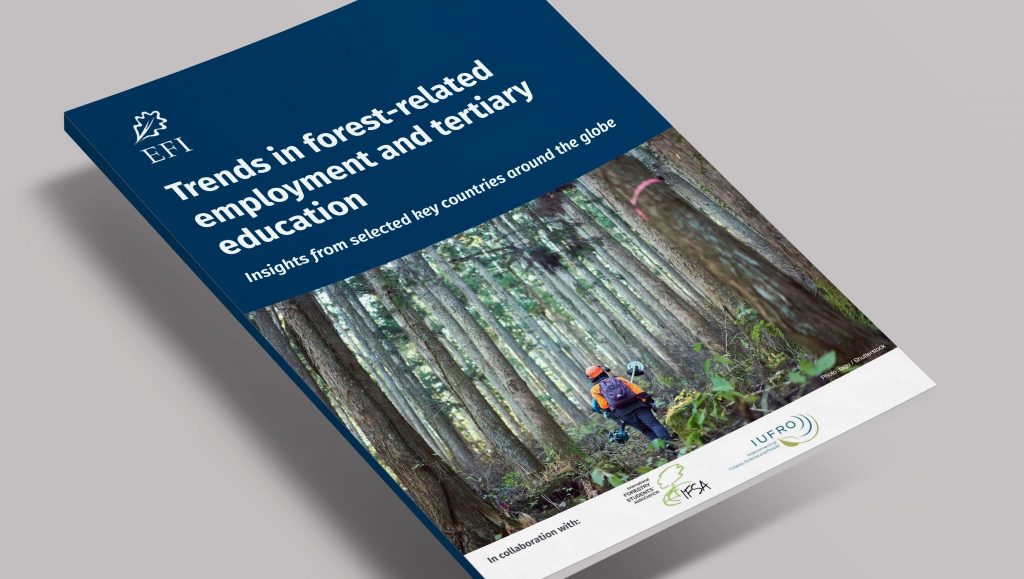NOTE: This text is reblogged without changes from a blog post authored by Juliet Achieng that originally appeared on the EFI Resilience Blog, https://resilience-blog.com/2021/11/11/from-tradition-to-innovation-insights-into-trends-in-forest-related-employment-and-tertiary-education/, on 11 November 2021.

From tradition to innovation: Insights into trends in forest-related employment and tertiary education
Despite their differences in e.g. climate, culture, and culinary preferences, you might be curious to find out what Brazil, China, Finland, Germany, Indonesia, South Africa and United States of America have in common.
The seven countries represent 42.7% of the global forest cover; and six out of the seven countries were among the top producers of forest products globally in 2018. Thus, the forest sector contributes significantly to their Gross Domestic Product (GDP) and creates a high number of full-time equivalent (FTE) jobs (FAO Global Forest Resources Assessment Report, 2015). But when we speak about jobs, do we know what changes are happening in forest-related employment in these countries? What are the major drivers of these changes? What is the state of forest-related green jobs there? How are the countries’ forest-related tertiary education programmes addressing these changes? And what is the future of forest-related employment and education in these countries?
In November 2019, close to 20 senior experts on forest-related employment and green jobs, and selected students with knowledge on forest education from the seven countries met in Bonn for a workshop organized by European Forest Institute. The joint aim of the activity was to primarily identify the trends in forest-related employment including adjacent and emerging fields such as green jobs. Secondly, the group examined forest-related tertiary education in the seven countries while looking at universities offering forest-related tertiary programmes, and enrolment trends in terms of numbers of students and graduates, as well as new programmes developed by those universities. The experts were drawn from research institutions, private companies, academia and international organizations. Representatives from the UNECE & FAO Team of Specialists (ToS) on Green Jobs in the Forest Sector also participated in the workshop and provided useful insights to the discussions.

The workshop resulted in a report titled “Trends in forest-related employment and tertiary education: insights from selected key countries around the globe”. The report is part of the “Global student networking and green jobs in the forest sector project”, a capacity development project coordinated by the European Forest Institute (EFI) in collaboration with the International Forestry Students’ Association (IFSA) and the International Union of Forest Research Organizations (IUFRO). The data we used for this study was obtained from numerous sources such as government documents and administrative records, statistic databases and statistical yearbooks and academic articles. Full references to the original data are provided wherever possible.
Some of the key messages from the report include:
- Overall employment in “traditional” forestry focused on timber production and logging is on the decline in most of the studied countries.
- The use of innovative wood-based products like laminated veneer lumber, cross laminated timber (CLT), substitutes for plastics and wood-based textile fibres is on the rise.
- The importance of environmental services to society for employment is on the rise as well as demand for downstream services such as environmental education, health services, recreation and tourism based on forests.
- Job quality in the forest sector remains a challenge, in addition to the high accident frequencies, the wages are lower than the national average minimum wages in many countries.
- A shortage of forest workers is being experienced in countries like Finland and Germany, hence the need by these countries to recruit short-term foreign workers to fill the gap.
- The phenomenon of green jobs as defined in this report is observed in all countries, however the use of the term green jobs varies among the countries studied, and so does the connotation given to it.
- There is some evidence that green jobs transform occupational profiles and workforce composition. They can also contribute to the creation of new forest-related employment opportunities.
- The number of tertiary level graduates from forest-related programmes has strongly increased in the emerging economies Brazil, China, Indonesia, and to a lesser extent South Africa. In these countries, there has been an emphasis on upgrading and formal recognition of skills.

However, despite the insightful outcomes of our work, important knowledge gaps in forest-related employment and education still remain. There is need to explore ways of making forest-related employment attractive to young people and to secure highly qualified workforce, including at graduate level. We need to investigate the extent to which green jobs will impact employment in the forest sector. Answers to these questions will have important implications for policies on forests, forest-related employment and education. And we need global studies on these topics to enable comparability across countries and regions.
If you want to find out more information about the report and how to download it, click here.
Photos: Juliet Achieng Owuor

Leave a Reply